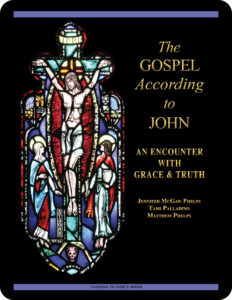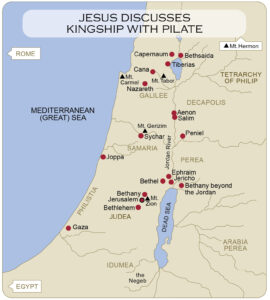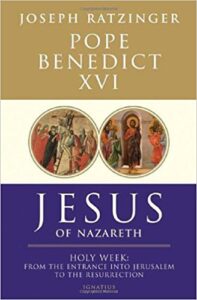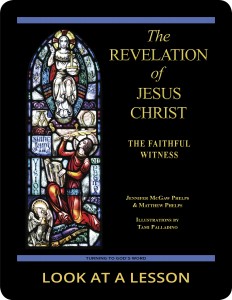 The Gospel According to John:
The Gospel According to John:
An Encounter with Grace & Truth
Lesson 22 My Kingship Is Not of This World
the Gospel According to John 18:28—19:16
Revised Standard Version Catholic Edition (RSVCE)*
New American Bible Revised Edition (NABRE)*
Catechism of the Catholic Church
ex libris (in our library)
glossary for the Gospel According to John
cross references in the Gospel According to John
next lesson: It Is Finished
This material coordinates with Lesson 22 on pages 116–120 in The Gospel According to John: An Encounter with Grace & Truth.
“Now Jesus did many other signs in the presence of the disciples, which are not written in this book; but these are written that you may believe that Jesus is the Christ, the Son of God, and that believing you may have life in his name.”—the Gospel According to John 20:30–31
welcome to our in-depth study of the Gospel According to John
We invite interested groups and individuals to check out the sample first lesson from this 25- lesson Turning to
lesson Turning to  God’s Word Catholic Bible study. These online study pages link to our free lesson videos, as well as to a glossary and cross references in the biblical text. Other study aids include maps, additional commentary, and prayers based on the primary Scripture in each lesson. The Gospel According to John: An Encounter with Grace & Truth has been granted an imprimatur and can be purchased from our website shop. If you have a Bible-related question or comment, click on one of the “ask us your question” or “what do you think” buttons on any online study page.
God’s Word Catholic Bible study. These online study pages link to our free lesson videos, as well as to a glossary and cross references in the biblical text. Other study aids include maps, additional commentary, and prayers based on the primary Scripture in each lesson. The Gospel According to John: An Encounter with Grace & Truth has been granted an imprimatur and can be purchased from our website shop. If you have a Bible-related question or comment, click on one of the “ask us your question” or “what do you think” buttons on any online study page.
open with prayer
It’s always wise to begin any Bible study with prayer, whether reading the Scriptures alone or meeting with others in a discussion study group. You can pray using your own words or use one of the opening prayers on our website. We especially like the following:
Lord Jesus, you promised to send your Holy Spirit
to teach us all things.
As we read and study your word today,
allow it to touch our hearts and change our lives. Amen.
let’s review—the Gospel According to John 18:1–27
In Lesson 21 Whom Do You Seek? the situation leading to Jesus’ Passion, death, and Resurrection escalates with Jesus’ arrest in a garden, which the synoptic Gospels According to Matthew, Mark, and Luke identify as Gethsemane. The Fourth Gospel depicts Jesus in control of the situation, asking the soldiers and officers who it is that they’re seeking. When Jesus replies “I am he,” those who have come to arrest Jesus fall on the ground. Simon Peter, in typical rash behavior, draws his sword and cuts off the right ear of a slave of the high priest. Although Jesus reprimands Peter, the Evangelist John fails to record in the Fourth Gospel that Jesus heals the slave. Jesus is taken to Annas, father-in-law of the high priest Caiaphas, and Simon Peter and another disciple whom scholars identify as the Evangelist John follow. Jesus is questioned about his teaching and denies saying anything secretly. Annas sends Jesus to Caiaphas. While waiting in the courtyard, Peter three times denies knowing Jesus.
map notes—now what time is it?
The Gospel According to John 18:28 records “It was early” when Jesus was taken from the house of Caiaphas to the Praetorium, the place where Roman business was conducted. Although none of the  Evangelists specify the time of day when this happened, the Gospels According to Matthew, Mark, and Luke also consistently record that it took place early in the morning. In the Gospel According to John 19:13, the Evangelist specifies that the time when Pilate moved to the judgment seat was about the sixth hour. Because the Romans marked time the same way that we do (counting from midnight and noon), Jesus’ death sentence would have been handed down about 6 a.m., the hour of the day that the Romans began conducting legal business. For more about the difference between Hebrew and Roman time, refer to “Does Anybody Know What Time It Is?” on the online study page for Lesson 5 There Came a Woman of Samaria in this study. Click on the image (right) to enlarge the map, which appears on page 119 in The Gospel According to John: An Encounter with Grace & Truth.
Evangelists specify the time of day when this happened, the Gospels According to Matthew, Mark, and Luke also consistently record that it took place early in the morning. In the Gospel According to John 19:13, the Evangelist specifies that the time when Pilate moved to the judgment seat was about the sixth hour. Because the Romans marked time the same way that we do (counting from midnight and noon), Jesus’ death sentence would have been handed down about 6 a.m., the hour of the day that the Romans began conducting legal business. For more about the difference between Hebrew and Roman time, refer to “Does Anybody Know What Time It Is?” on the online study page for Lesson 5 There Came a Woman of Samaria in this study. Click on the image (right) to enlarge the map, which appears on page 119 in The Gospel According to John: An Encounter with Grace & Truth.
 Jesus is crowned … with thorns (01:13:15)
Jesus is crowned … with thorns (01:13:15)
In the video for this lesson, Turning to God’s Word author Matthew Phelps  discusses the crown of thorns that the Gospel According to John 19:1–2 records the soldiers placing on Jesus’ head. Crowns developed to distinguish rulers, often referred to as “heads” of state. The shape of the human skull suggested circular adornment, which originally signified that God’s power had been imparted to the person wearing the crown, who was considered to be governing as God’s representative. A crown was a sign of honor. Jesus’ crown of thorns is in the Roman style of a wreath
discusses the crown of thorns that the Gospel According to John 19:1–2 records the soldiers placing on Jesus’ head. Crowns developed to distinguish rulers, often referred to as “heads” of state. The shape of the human skull suggested circular adornment, which originally signified that God’s power had been imparted to the person wearing the crown, who was considered to be governing as God’s representative. A crown was a sign of honor. Jesus’ crown of thorns is in the Roman style of a wreath  and is intended as an insult. The Roman soldiers are mocking Jesus’ followers’ hope that Jesus would be an imposing Messiah-King able to wield political and military power much the same way that David did.
and is intended as an insult. The Roman soldiers are mocking Jesus’ followers’ hope that Jesus would be an imposing Messiah-King able to wield political and military power much the same way that David did.  During the Lenten season, you can check out Jesus’ Passion: The Story of Redemptive Suffering, which isn’t available at other times of the year.
During the Lenten season, you can check out Jesus’ Passion: The Story of Redemptive Suffering, which isn’t available at other times of the year.
The Scripture ranges for the videos that accompany this Catholic Bible study match the Scripture ranges for the sets of questions in The Gospel According to John: An Encounter with Grace & Truth. You can follow along with the video overview as Turning to God’s Word author Matthew Phelps discusses Lesson 22, “My Kingship Is Not of This World,” on pages 116–120 in the study book.
WHAT DO YOU THINK about dual views of kingship?
This section in the Gospel According to John focuses on the role that truth plays in two very different views of kingship. While there are suggestions in the biblical text that Pilate understands Jesus is innocent of any charges trumped up by the Jewish religious leaders, the Roman governor still attempts to ignore truth even when it’s standing right in front of him in the person of Jesus.
 ? Have you ever been in a sticky situation and tried to ignore reality by playing dumb and pretending it is impossible to know the truth?
? Have you ever been in a sticky situation and tried to ignore reality by playing dumb and pretending it is impossible to know the truth?
? What has Jesus provided for Christians to help us avoid making a mistake about the truth similar to the one made by Pilate?
? What role does truth play in the way Christians can more closely align with the spiritual kingdom?
 kingdom of heaven—you could look it up in our archives
kingdom of heaven—you could look it up in our archives
In his conversation with Jesus, Pilate seems interested in learning as much as he can about Jesus’ kingdom—but the truth eludes him. To learn about the kingdom of heaven, read Lost in Translation, an online column in which Turning to God’s Word author Matthew Phelps helps readers connect with ideas expressed in the original languages of the Scriptures. New Lost in Translation entries are posted on Mondays, and past entries are archived on our website. Contact us if you’d like to receive Lost in Translation by email every week. The Turning to God’s Word in-depth Catholic Bible studies The United Kingdom of Israel: Saul, David & Solomon Foreshadow Christ the King
Mondays, and past entries are archived on our website. Contact us if you’d like to receive Lost in Translation by email every week. The Turning to God’s Word in-depth Catholic Bible studies The United Kingdom of Israel: Saul, David & Solomon Foreshadow Christ the King  and Thus Says the LORD: God Speaks Through His Servants the Prophets—Volume I: A Kingdom Divided provide historical background about the regional kingdoms described in the Old Testament.
and Thus Says the LORD: God Speaks Through His Servants the Prophets—Volume I: A Kingdom Divided provide historical background about the regional kingdoms described in the Old Testament.
 the popes inspire us—force of truth
the popes inspire us—force of truth
The papal quote “Force of Truth” on page 118 in The Gospel According to John: An Encounter with Grace & Truth is based on the biblical text upon which this lesson is based—the nineteenth chapter of the Gospel According to John. In the commentary in the study book, Pope St. John Paul II examines details in the biblical text in order to teach about the reality (the truth) of facts that allows us to receive the gift of faith.
pray with the Psalms—songs of royal enthronement
Psalm 24 is one of a number of enthronement Psalms believed to be sung as part of the liturgical  ceremony to anoint a new king. These ancient prayers address God as king and are referred to as royal Psalms or enthronement Psalms. Classifications of these prayers vary from one scholar to the next, but a collection of royal Psalms often includes these six in addition to Psalm 24: Psalm 47, Psalm 93, Psalm 96, Psalm 97, Psalm 98, and Psalm 99. Although Christians understand these Psalms in connection with Christ the King, they originally were written to honor earthly kings. Psalm 24 describes an ideal king who is worthy to stand in
ceremony to anoint a new king. These ancient prayers address God as king and are referred to as royal Psalms or enthronement Psalms. Classifications of these prayers vary from one scholar to the next, but a collection of royal Psalms often includes these six in addition to Psalm 24: Psalm 47, Psalm 93, Psalm 96, Psalm 97, Psalm 98, and Psalm 99. Although Christians understand these Psalms in connection with Christ the King, they originally were written to honor earthly kings. Psalm 24 describes an ideal king who is worthy to stand in  the LORD’s holy place (to stand in for the LORD as ruler of the people). The king’s noble characteristics include having clean hands and a pure heart, not having sought vain things, and not having sworn deceitfully. Prayed as part of Wednesday Vigils (Week I), Psalm 24 will be included as part of Lesson 7 The LORD Remembers His Holy Word in the Turning to God’s Word Catholic Bible study Sing a New Psalm: Communicating with God Through the Prayers of the Church—Volume II: Vigils, Day Prayer & Compline. That study is scheduled for release in 2025.
the LORD’s holy place (to stand in for the LORD as ruler of the people). The king’s noble characteristics include having clean hands and a pure heart, not having sought vain things, and not having sworn deceitfully. Prayed as part of Wednesday Vigils (Week I), Psalm 24 will be included as part of Lesson 7 The LORD Remembers His Holy Word in the Turning to God’s Word Catholic Bible study Sing a New Psalm: Communicating with God Through the Prayers of the Church—Volume II: Vigils, Day Prayer & Compline. That study is scheduled for release in 2025.
ex libris—learn more about Jesus’ Passion, death & Resurrection
 In Jesus of Nazareth: Holy Week, the second of a three-part series based on information about Jesus found in the
In Jesus of Nazareth: Holy Week, the second of a three-part series based on information about Jesus found in the  Gospels, Pope Benedict XVI looks at the decisive events and sayings that are the focus
Gospels, Pope Benedict XVI looks at the decisive events and sayings that are the focus  of Jesus’ last week on earth. The Scripture covered begins with Jesus’ entrance into Jerusalem and continues through the time of his Resurrection. Read excerpts and learn more about all three volumes of Jesus of Nazareth and other works related to Bible study at ex libris—main bookshelf.
of Jesus’ last week on earth. The Scripture covered begins with Jesus’ entrance into Jerusalem and continues through the time of his Resurrection. Read excerpts and learn more about all three volumes of Jesus of Nazareth and other works related to Bible study at ex libris—main bookshelf.
for additional reflection
The Fourth Gospel is known for its “irony,” a word that simply means things that are contrary to what normally would be expected. The following questions are designed to help readers begin to form their own thoughts and ideas related to the Gospel According to John 18:28—19:16. For more reflection questions, refer to the introduction to Lesson 22 on page 116 in The Gospel According to John: An Encounter with Grace & Truth.
 ? List examples of irony in the biblical text for this lesson.
? List examples of irony in the biblical text for this lesson.
? Compare your list with the examples in “Irony” on page 119 in The Gospel According to John: An Encounter with Grace & Truth.
? Which example of irony in this section of the Gospel According to John do you find the most alarming?
? Consider whether Christian beliefs continue to be misunderstood in the present-day world.
the best Catholic commentary about Scripture
 To find out more about how Church teaching is supported by Scripture passages in The Gospel According to John: An Encounter with Grace & Truth, check out the Index of Citations in the Catechism of the Catholic Church. Links to the primary Scripture passages in the lesson (Revised Standard Version Catholic Edition [RSVCE*]) and relevant paragraphs in the Catechism are provided here. Not every passage in the biblical text for this study is referenced in a Catechism paragraph, however.
To find out more about how Church teaching is supported by Scripture passages in The Gospel According to John: An Encounter with Grace & Truth, check out the Index of Citations in the Catechism of the Catholic Church. Links to the primary Scripture passages in the lesson (Revised Standard Version Catholic Edition [RSVCE*]) and relevant paragraphs in the Catechism are provided here. Not every passage in the biblical text for this study is referenced in a Catechism paragraph, however.
the Gospel According to John 18:31—paragraph 596
the Gospel According to John 18:36—paragraphs 549, 600
the Gospel According to John 18:37—paragraphs 217, 559, 2471
the Gospel According to John 19:11—paragraph 600
the Gospel According to John 19:12—paragraph 596
the Gospel According to John 19:15—paragraph 596
ways our glossary might prove helpful
In addition to providing extra information about geographical locations, our glossary also points out  persons and places mentioned in the biblical text under multiple names or spellings. If you can remember a name but aren’t sure in which lesson it shows up, you can find it in the glossary, which lists every proper noun that appears in the primary biblical text for The Gospel According to John: An Encounter with Grace & Truth.
persons and places mentioned in the biblical text under multiple names or spellings. If you can remember a name but aren’t sure in which lesson it shows up, you can find it in the glossary, which lists every proper noun that appears in the primary biblical text for The Gospel According to John: An Encounter with Grace & Truth.
to learn more, read more Scripture
If you’re having difficulty with a passage of Scripture, it can be helpful to read the relevant  cross references—but looking these up can take time. To make that easier, we’ve compiled the cross references from the Revised Standard Version Second Catholic Edition (RSV2CE)—the translation that we reprint in our study books. That list can be found at the top of every online study page accompanying this study, and it includes links to each of the cross references in the primary biblical text for The Gospel According to John: An Encounter with Grace & Truth.
cross references—but looking these up can take time. To make that easier, we’ve compiled the cross references from the Revised Standard Version Second Catholic Edition (RSV2CE)—the translation that we reprint in our study books. That list can be found at the top of every online study page accompanying this study, and it includes links to each of the cross references in the primary biblical text for The Gospel According to John: An Encounter with Grace & Truth.
don’t forget about our indexes & extra online material

 If you’re trying to locate information about a specific Scripture passage, you can look it up in the index at the back of the study book or sample lesson. If you want to find a particular commentary, you can look up its title in the topics index. To learn more about another book of the Bible for which there’s a Turning to God’s Word study, visit the online study directories to read the commentaries and watch any accompanying videos. Finally, if you have a question or would like to make a comment about any of our studies, you can use one of the “ask us your question” or “what do you think” buttons to email our authors.
If you’re trying to locate information about a specific Scripture passage, you can look it up in the index at the back of the study book or sample lesson. If you want to find a particular commentary, you can look up its title in the topics index. To learn more about another book of the Bible for which there’s a Turning to God’s Word study, visit the online study directories to read the commentaries and watch any accompanying videos. Finally, if you have a question or would like to make a comment about any of our studies, you can use one of the “ask us your question” or “what do you think” buttons to email our authors.
ex libris—Church documents & books about religious topics
You can find links to magisterial documents referred to in Turning to God’s Word Catholic Bible studies  at ex libris—magisterial documents. This page includes a listing of significant recent encyclicals as well as a number of historical Church documents. Recommended books related to Scripture study can be found at ex libris—main bookshelf.
at ex libris—magisterial documents. This page includes a listing of significant recent encyclicals as well as a number of historical Church documents. Recommended books related to Scripture study can be found at ex libris—main bookshelf.
wondering how to pronounce some of these words?
The following link is to a reading from the New International Version (NIV) Bible. To listen, click on the audio icon above the printed text. Although not taken from the translations used in our study materials, the NIV reading provides an audio guide to pronunciation of words in this lesson’s primary biblical text. A close online version of the translation of the Bible used in Catholic liturgy in the United States as well as an audio guide for daily Mass readings for the current month can be found on the website of the United States Conference of Catholic Bishops (USCCB).
the Gospel According to John 18:28—19:16 (NIV)
 close with Bible-based prayer related to this lesson
close with Bible-based prayer related to this lesson
Many of our Catholic study groups like to conclude their discussions with a prayer based on the scriptural focus of their lesson, and some participants include Scripture-specific prayer in their individual study. If you’re uncomfortable composing your own Bible-based prayers, you can follow our four easy steps, or you can use the following prayer based on this lesson’s text from the Gospel According to John.
God our Father, you sent your Son
to show us the majesty of your love.
Help us to accept the truth that Christ is King
and rules over all aspects of our lives.
We ask this through Jesus Christ, our Lord. Amen.
Lesson 23 It Is Finished—the Gospel According to John 19:17–42
Lesson 21 Whom Do You Seek?—the Gospel According to John 18:1–27
you also may like our study of the book of Revelation
 The Revelation of Jesus Christ: The Faithful Witness, a 23-lesson Catholic Bible study with an imprimatur, examines ways in which our traditional Christian view of heaven is built on Hebrew apocalyptic visions recorded in the Old Testament. This recently revised study includes maps and additional commentary and takes a close look at the role of the prophets in present-day Christianity. Illustrations by Tami Palladino depict the often-misunderstood images in the book of Revelation. Click on the book’s cover to view a sample lesson.
The Revelation of Jesus Christ: The Faithful Witness, a 23-lesson Catholic Bible study with an imprimatur, examines ways in which our traditional Christian view of heaven is built on Hebrew apocalyptic visions recorded in the Old Testament. This recently revised study includes maps and additional commentary and takes a close look at the role of the prophets in present-day Christianity. Illustrations by Tami Palladino depict the often-misunderstood images in the book of Revelation. Click on the book’s cover to view a sample lesson.
start a Turning to God’s Word Bible study
 Thank you for your interest in The Gospel According to John: An Encounter with Grace & Truth.
Thank you for your interest in The Gospel According to John: An Encounter with Grace & Truth.  Information about beginning a Turning to God’s Word Bible study can be found at start a Bible study. Tami, Matthew, and I are available to answer questions and offer support. Contact us if you’d like to start one of our studies or have your schedule listed with other TtGW study groups on our website. —Jennifer
Information about beginning a Turning to God’s Word Bible study can be found at start a Bible study. Tami, Matthew, and I are available to answer questions and offer support. Contact us if you’d like to start one of our studies or have your schedule listed with other TtGW study groups on our website. —Jennifer
*There are seven deuterocanonical books in the Old Testament—the Books of Tobit, Judith, Wisdom, Sirach, Baruch, and First and Second Maccabees, as well as some passages in the Books of Esther and Daniel. Protestants usually refer to these works as “apocryphal,” a word that means “outside the (Protestant) canon” because they’re excluded from most Protestant Bibles. The word “deuterocanonical” means “second canon”; Catholics use that word to refer to any section of the Catholic Old Testament for which there are no extant, or existing, Hebrew manuscripts. All of the deuterocanonical books appear in the Septuagint, the earliest remaining versions of which date to the 1st century B.C. This Greek translation of the Old Testament was in common use by Jews at the time of Jesus. Learn more by reading How Do Catholic & Protestant Bibles Differ?
Turning to God’s Word printed Bible studies use the 2006 Revised Standard Version Second Catholic Edition (RSV2CE) translation for all Scripture references except those to the Psalms, which are taken from The Abbey Psalms and Canticles, prepared by the Benedictine monks of Conception Abbey and published in 2020 by the United States Conference of Catholic Bishops (USCCB). All Scripture links for the online study pages for The Gospel According to John: An Encounter with Grace & Truth are to the 1966 Revised Standard Version Catholic Edition (RSVCE) translation. The New International Version (NIV) audio recordings follow the same chapter and verse numbering as the RSV Catholic translations, but the NIV translation doesn’t include the deuterocanonical books and passages.
The 1966 RSVCE uses archaic pronouns and verb forms such as “thee,” “thou,” “didst” in the Psalms and in direct quotations attributed to God. The 2006 RSV2CE replaces these with more accessible English. The few significant translation changes in the RSV2CE include rendering almah as “virgin” in the Book of Isaiah 7:14 and restoring the term “begotten” in the Gospel According to John 3:16.
Numbering varies for some passages in this Bible study. Turning to God’s Word studies (print and digital) follow the numbering in the Revised Standard Version Catholic translations (RSV2CE and RSVCE). Discrepancies in the New American Bible Revised Edition (NABRE) are noted in the Index of Scripture Citations in the study book and the online sample.
 You can learn more about the Psalms by viewing a sample lesson from the Turning to God’s Word Catholic Bible study Sing a New Psalm: Communicating with God Through the Prayers of the Church—Volume I: Lauds & Vespers. The second part of that study, Sing a New Psalm: Communicating with God Through the Prayers of the Church—Volume II: Vigils, Day Prayer & Compline, is scheduled for publication in 2025. Some verse numbers may vary in different translations of the Psalms.
You can learn more about the Psalms by viewing a sample lesson from the Turning to God’s Word Catholic Bible study Sing a New Psalm: Communicating with God Through the Prayers of the Church—Volume I: Lauds & Vespers. The second part of that study, Sing a New Psalm: Communicating with God Through the Prayers of the Church—Volume II: Vigils, Day Prayer & Compline, is scheduled for publication in 2025. Some verse numbers may vary in different translations of the Psalms.
